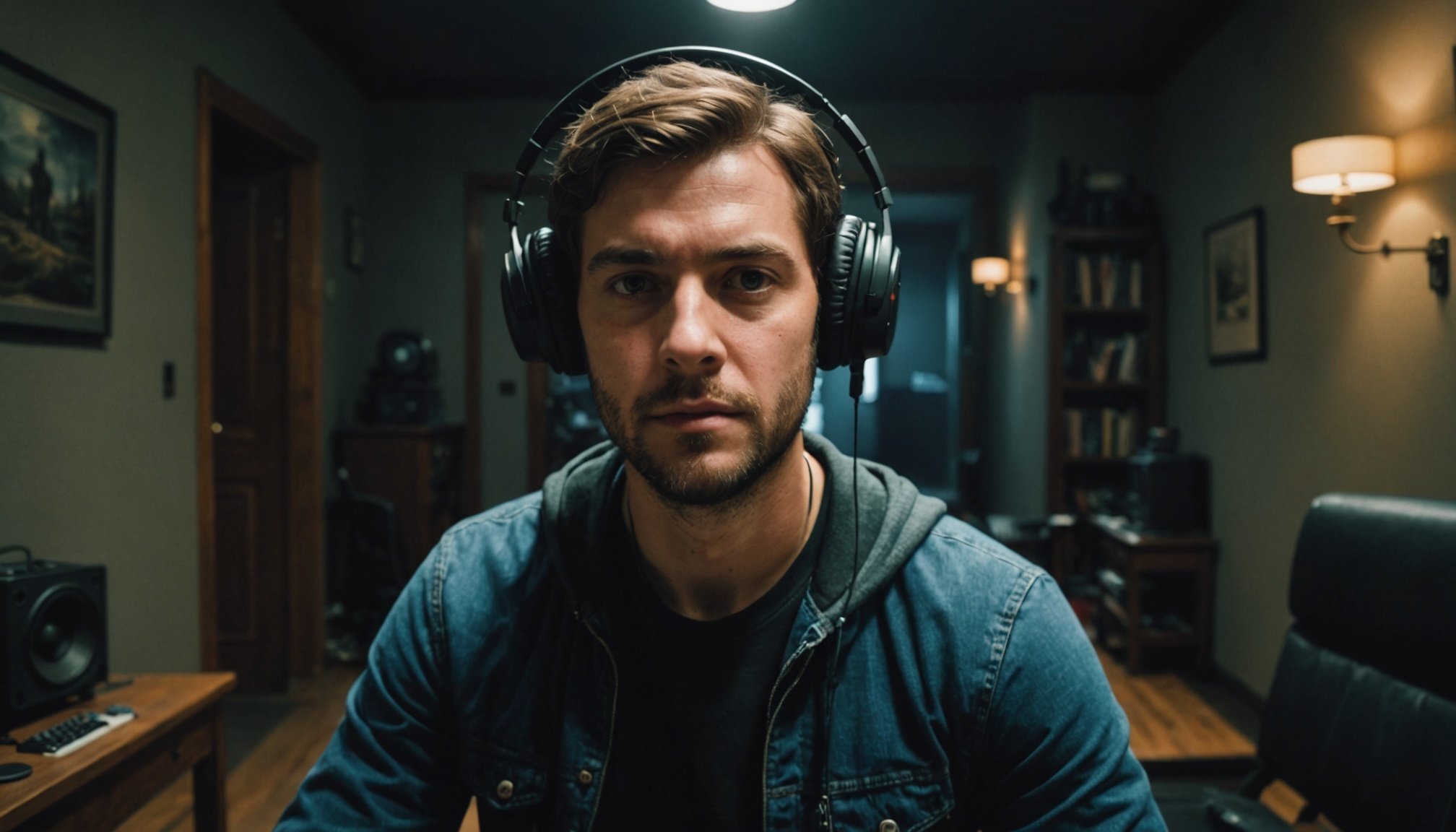Overview of Binaural Sound in Horror Games
Binaural sound is a cutting-edge advancement in immersive audio, transforming the landscape of horror game development. This technique involves recording sound using two microphones placed to mimic human ear placement, offering a 3D audio experience. This method surpasses traditional stereo or mono sound by delivering a more realistic and spatial listening experience, crucial for engaging horror gameplay.
Traditional audio techniques often fail to replicate the surrounding environment accurately. Stereo sound, for instance, may provide a sense of directionality but lacks depth and realism. Mono audio is even more limited, offering minimal spatial awareness. Herein lies the advantage of binaural sound: its capacity to craft more immersive and believable atmospheres.
In terms of player experiences, binaural sound dramatically heightens tension and suspense. By simulating how sounds naturally move and interact with space, players perceive audio cues as if they were physically present in the game world. This immersion fosters an unparalleled emotional connection and can magnify the fear factor, crucial for horror games where atmosphere is everything.
Developers adopting binaural sound not only deliver authenticity but also keep players on edge—transforming each creak or whisper into a chilling encounter. Understanding its profound effects offers insights into the future trajectory of audio design in gaming.
In parallel : Elevating gameplay: enhancing survival game crafting systems with real-world physics for ultimate fun
Technical Specifications for Binaural Sound Integration
Incorporating binaural sound into your projects demands a well-chosen technical audio setup. Hardware and software are the first essentials you need. For developers aiming to achieve lifelike audio experiences, investing in high-quality headphones and sound cards is crucial, as these are foundational for precise audio playback.
Once your hardware is secured, focus on the right game engine integration. Popular engines like Unity and Unreal Engine provide robust support for binaural audio. Unity, for instance, offers plug-ins such as Resonance Audio that seamlessly integrate spatial audio into your development process. Unreal Engine, known for its expansive features, supports binaural audio through its Audio Engine.
To enhance your sound design, choosing the right spatial audio tools is key. Audio tools like DearVR and Oculus Spatializer are highly recommended for developers aiming to excel in binaural sound. These tools allow intricate tweaks and adjustments, ensuring the sound is accurately positioned, providing an immersive experience for users.
Finally, consider these plug-ins as part of your toolkit, allowing greater flexibility and precision in your projects. Armed with the right technology and tools, developers can create stunning, immersive audio experiences that resonate well with audiences.
Design Considerations for Binaural Audio in Horror
Creating an unsettling atmosphere in horror games hinges on impeccable audio design. By harnessing audio cues that amplify fear and tension, developers can craft genuinely spine-chilling experiences. The intricate interplay between ambient sounds and gameplay interactions is fundamental. Ambient sounds, such as rustling leaves or distant whispers, can induce a lingering unease, contrasting dynamically with direct audio cues like footsteps or monster growls to jolt players at climactic moments.
In horror game mechanics, sound design isn’t merely about scaring players; it’s also about guiding them. The strategic deployment of audio can establish spatial awareness, effectively immersing players in the game’s world. Such an immersive experience can be achieved by enveloping players in a 3D soundscape that places audio sources accurately within the game environment.
To enhance immersive gameplay, developers can experiment with volume, pitch, and directionality. By adjusting these audio elements, players can be tricked into feeling like they are in the middle of the horrors themselves. This meticulous balance demands a careful selection of sounds to support narrative pacing without overwhelming players. Effective binaural audio should lead to a harmonious blend where every whisper, creak, and echo are tangible, elevating the horror experience to new frightful heights.
Case Studies of Successful Binaural Sound Integration
Binaural sound has significantly impacted various games, enhancing immersion through unique audio experiences. Focusing on notable examples showcases the technique’s potential and broad influence.
Notable Game Example 1
One prominent title leveraging binaural sound is the renowned horror game, here referred to as “Spectral Realms.” This game ingeniously incorporates binaural audio to craft unsettling horror soundscapes. By employing advanced techniques like dynamic positioning and realistic environmental noise, “Spectral Realms” deeply immerses players. Gamers have particularly praised its dizzying sense of realism, as sound seems to originate from precise directions, inducing genuine unease. Player feedback frequently highlights how the meticulously designed sound enhances tension, praised as a pivotal element of the game examples.
Notable Game Example 2
Another striking success is the thriller “Echolocation Endgame,” which utilizes binaural audio to address specific game examples challenges like player disorientation in complex environments. Through strategic use of spatial sound cues, it navigates an auditory experience that guides players without overt visual markers. This meticulous sound design enriches gameplay, receiving acclaim for its seamless integration into the overall experience. The engaging player feedback notes how such auditory immersion fosters a unique connection to the game’s world, celebrating it as a groundbreaking achievement in interactive audio.
By examining these case studies, it’s evident that horror soundscapes and binaural techniques significantly elevate player involvement. Insights drawn from these successes can inspire future game examples and development, emphasizing the value of incorporating refined audio to match players’ expectations and enrich gaming narratives.
Practical Applications and Challenges
Integrating binaural sound into games introduces its own set of implementation challenges, from technical constraints to maintaining audio quality across diverse devices. Game developers often struggle with ensuring sounds are accurately transmitted and experienced, mirroring the three-dimensional space they aim to replicate.
Audio testing becomes crucial, demanding meticulous attention to how sounds resonate and how they interact with other game elements. Effective audio testing involves not only checking sound quality but also assessing how changes affect gameplay dynamics and player immersion. This calls for regular and rigorous testing cycles to refine the experience continually.
A practical solution lies in adopting an iterative design approach, where developers update and refine game audio based on player feedback. Engaging with users can offer critical insights into how binaural sound is perceived in real-world gaming scenarios. Strategies could include using beta testing phases or community forums to gather and analyse player input.
Additionally, by building a structured framework for quality assurance, developers can address potential impediments early. Emphasising iterative design allows for adjustments that enhance experience and satisfaction, ensuring that binaural sound integrates seamlessly. This cycle of feedback and refinement optimises the audio landscape, aligning with player expectations while pushing the boundaries of sound in gaming.
Future Trends in Binaural Sound for Horror Games
In the rapidly evolving world of gaming, emerging technologies are at the forefront of creating immersive experiences. Binaural sound, an innovative audio approach, is significantly shaping the gaming future, especially in the horror genre. By providing a three-dimensional sonic environment, it enhances the horror narrative, making it more engaging and spine-chilling for players.
Audio innovation in binaural technology entails capturing sound as humans naturally hear it, which allows developers to create atmospheres that mimic real-world scenarios. This not only intensifies the player’s sensory experience but also deepens their emotional connection to game characters and plots. As real-world audio advancements continue to progress, these technologies have the potential to revolutionise horror gaming by adding layers of realism that were previously unattainable.
Looking ahead, predictions suggest that binaural sound will become more intricate, with interactive experiences presenting dynamic audio that adjusts in real-time to player actions and environments. This evolution could lead to truly personalised horror experiences, where each gameplay session offers unique auditory surprises. As developers embrace these advancements, the horror genre is poised to become an even more thrilling frontier in the digital landscape.











